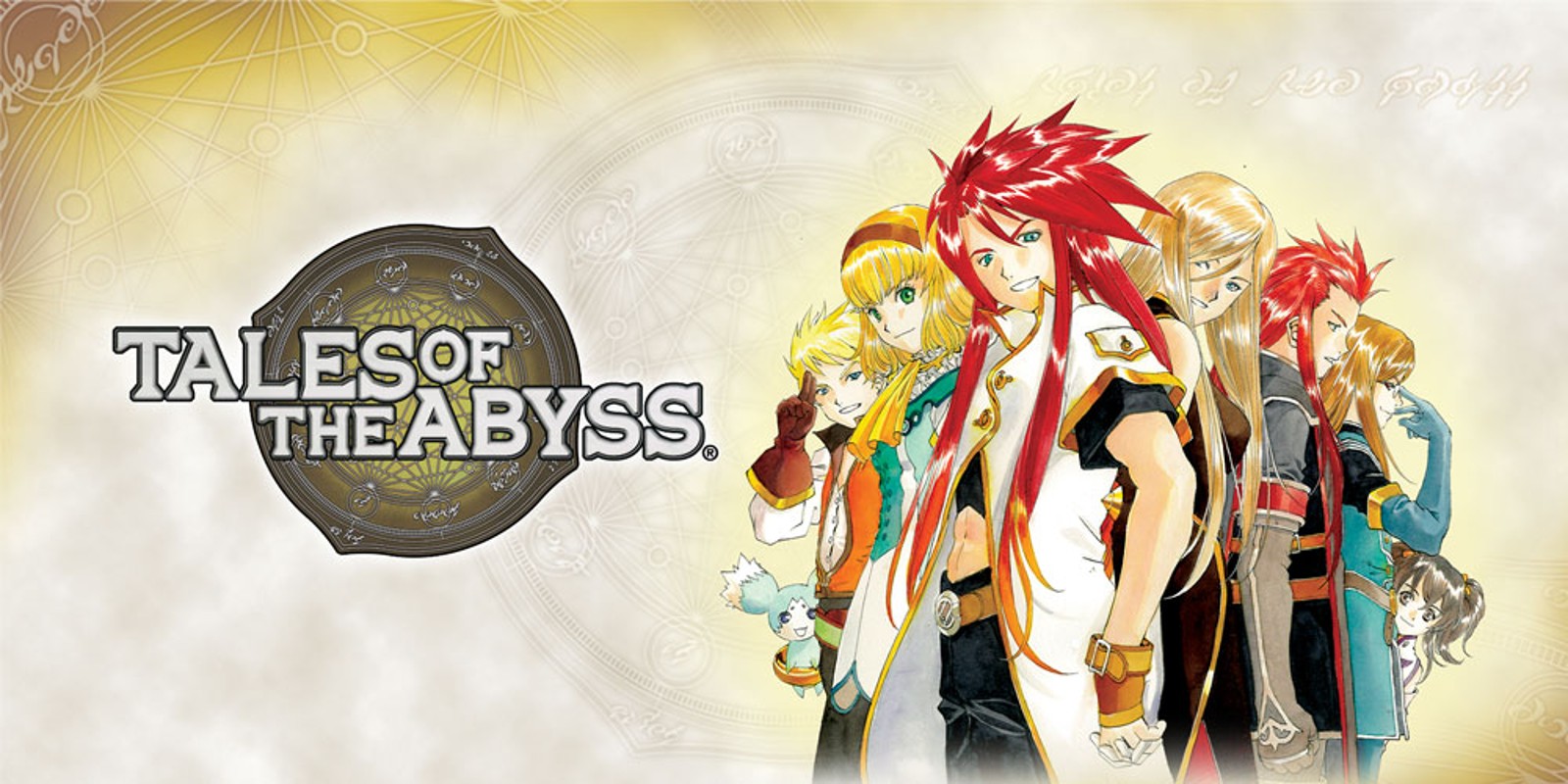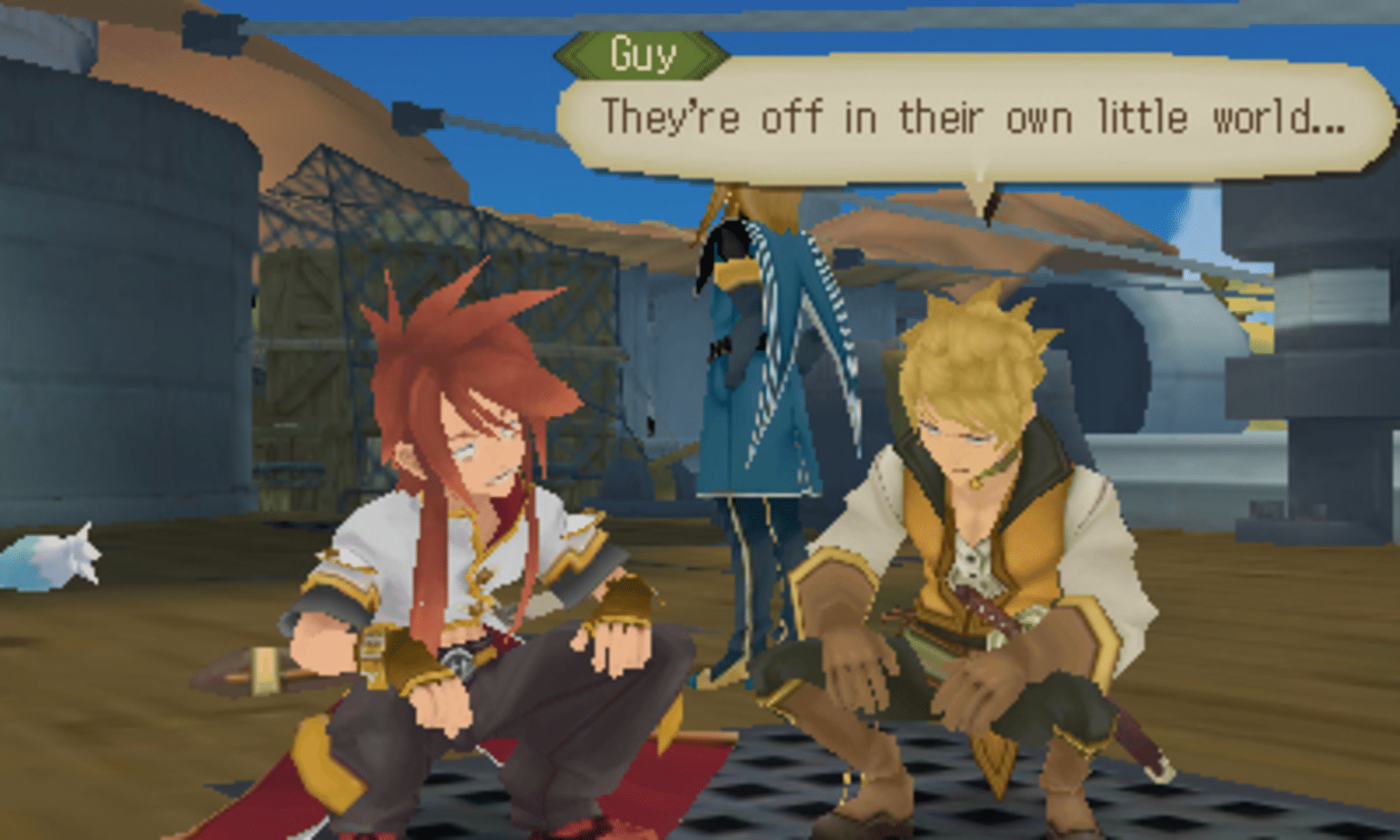
It’s hard to believe that it’s been almost a year since the 3DS launched and there’s only one RPG on it. That may change in the near future, but in the meantime, a last-gen gem has been released for the handheld system, and there’s no question that it’s one of the best entries in the Tales series. Tales of the Abyss was released by Bandai Namco Games without much fanfare, but Tales veterans and 3DS owners who were eager for a shiny new handheld RPG have been waiting with bated breath, and it was everything they expected, for better or worse.
Tales of the Abyss is set in the world of Ordrant, where two nations, Malkuth and Kimlasca-Lanvaldia, adhere to a written world history called the Score. This world history prophesies that the world will prosper as long as it is maintained. To this end, the Lorelei Cult was founded to further advance the world towards the future predicted by the Score. The player controls Luke, the son of an aristocrat and heir to the throne of Kimlasca. Seven years before the start of the game, Luke was abducted by the Malkuth Empire and lost his memory due to the shock. Because of this, his father forbids him from leaving the house and places him under house arrest until his 20th birthday. At the start of the game, Luke is in the middle of a regular training session with his teacher and friend Van Grantz when suddenly an assassin appears and attacks Van. Luke tries to protect his teacher, but his efforts are unsuccessful and he is teleported to the Unknown Regions along with the aspiring assassin. Luke and the assassin Tia must return to Luke’s hometown of Batikal.
Luke is initially the most annoying character in the game as he has the propriety and manners of a seven-year-old who is used to always getting his way. Luke is a character that is completely different from the heroes in the Tales games so far. He is selfish, arrogant, and generally behaves like a total idiot towards everyone. There are good aspects to his actions, but it is often overshadowed by his self-centered nature. This ultimately makes Luke’s character development one of the best the Tales series has to offer, as Luke’s evolution from a selfish aristocrat to something bigger is incredibly well written.

The other player characters are not as developed as Luke, but he is one of the most three-dimensional characters in the series. Unfortunately, somewhere between designing the characters and creating their dialogue, the development team forgot to make them likable. While their interactions and conversations are incredibly funny (some of the best in any Tales game), all of the main characters behave like intense sociopaths. The way the story unfolds turns even the most harmless characters into pretty obnoxious nuisances, which is a shame since Abyss features some of the best writing in the series. I wish the characters had been a bit more likable. The only character I liked is Guy. He is consistently kind and cheerful towards his teammates and, aside from a few personal quirks, is probably the mildest character of the cast.
More important than the main story itself are the consistent themes of the plot. Abyss’ plot is character-driven, just like the previous games, but overall more meaningful. She examines the nature of birth, nature vs. upbringing, and the concept of destiny. Are the circumstances of our birth all that define us? Does our identity depend entirely on genetics or upbringing? Do we truly control our destiny, or are we merely cogs in a machine that is guaranteed to thrive as long as we keep it moving?
Abyss, despite its usual lack of subtlety, handles these concepts with a maturity and depth that other Tales games and most other JRPGs have never attempted. Many of the plot twists and developments are made incredibly obvious by constant hints from the protagonist throughout the game’s story. Foreshadowing is an important literary device, but only when used correctly. Abyss basically explains the entire plot by winking and nudging the player from off-screen. In any case, the main plot and character development are expertly woven together, and the game’s ending avoids the feel-good “happy ending” that plagues most JRPG stories, with an incredibly satisfying, yet fittingly bittersweet, final scene.
When Abyss was released for the PlayStation 2 in 2006, it was far from a graphical monster, but it suffered from slowdowns, glitches, and technical issues, probably because Bandai Namco Games needed to release it in Japan to coincide with the series’ 15th anniversary. The 3DS port fixed most of the issues; loading times are almost completely gone, and no glitches or technical issues bothered me while playing. Some slowdowns remain, however, as does the overworld fog effect that obscured pop-in in the PlayStation 2 version. Ultimately, the port still shows signs of graphical imperfections, but they’re nothing that ruin the game.

Maybe it’s because of the smaller screen, but the graphics seem to get a bit worse when switching to handheld. The graphics are slightly lower resolution and the colors look a bit washed out, but otherwise there’s nothing particularly wrong with them. While technically impressive, it looks very generic and doesn’t have the stylized art direction of other games in the series. The 3D effects, as we’ve come to expect from a port, are rather tame and don’t add much. There are moments when the 3D suddenly switches to 2D, such as during combat transitions, which is confusing and somewhat frustrating. Given that the 3D elements are essentially unnecessary, Abyss is best played with the 3D turned off.
Sakuraba’s work in the game isn’t his best, but it’s not his worst either. The music isn’t particularly memorable, but it’s not nerve-wracking either. Abyss’ soundtrack was made at a time when Sakuraba’s work wasn’t as corny, and as far as series soundtracks go, Abyss is right up there. The main voice cast is fantastic. Namco has assembled a fantastic cast of voice actors for the English narration, including some big names in the world of anime dubbing. The actors have great chemistry and hit just the right tone. It’s a shame Namco couldn’t get voices to voice the sketches this time around, but it makes sense considering the costs involved. The voice acting in Abyss is virtually top notch.
Where Abyss really shines is in the gameplay. As the last Tales game of the previous generation before Team Symphonia moved to current hardware, Abyss combined the successful combat system of Tales of Symphonia with a new character development system and combat mechanics. In addition to regular leveling up, characters in Abyss can be equipped with Capacity Cores that increase their attributes by a set amount as they level up. Each Capacity Core is designed for a specific type of fighter; one focuses on high physical attack and defense, while the other is tuned to be balanced but with lower stat growth spread across all character stats.
These additional stat buffs serve a much more useful purpose than simply improving a character’s abilities. Also, reaching certain overall stat thresholds unlocks special abilities that improve combat effectiveness and efficiency. Some abilities increase the number of attacks that can be used in a basic combo, while others give the character extra defense against certain attacks. However, each character serves a specific function in combat, such as: B. Fighter, Healer, Wizard, so there isn’t a lot of potential for character diversification, but it does allow for some customization without the worry of hitting an insurmountable wall later in the game due to insufficient character development. On the other hand, hardcore players can increase the difficulty to extreme levels, which will require judicious use of capacity cores.

Combat features the Linear Motion Combat System the series is known for. Encounters occur when the player comes into contact with an enemy in the overworld or dungeons, and combat itself is action-oriented rather than turn-based. Players can link attacks and moves into combos, and the moves themselves can be upgraded in FS Chambers, which allow for countless improvements to moves. Tales games often make new contributions to the series’ combat system with each new iteration, and Abyss’s addition is the Field of Phonon (FOF). When a certain elemental attack is performed on the battlefield, a small circle appears on the ground indicating the attack’s element. Using certain attacks while standing within these circles will give you modified moves that can extend your regular combos.
Field of Phonons is a novel approach to combat for the series, and while it can be useful at times, it’s not present consistently enough to change up the game’s fights. The FOF circle disappears after 5 seconds, but even so, it’s very rare to catch an enemy with one of the modified moves, since most of the time the enemy is not near the circle. It would have been a better gameplay element if the FOF circle could have remained on the screen for the remainder of the battle, forcing the player to adapt to a dynamic and constantly changing battlefield. As it stands, FOF is more of a lost potential than a useful addition to the combat system.
The dual-screen setup is also a missed opportunity. There is almost no touchscreen integration as Abyss is a direct port with no extra features. The lower screen is dedicated to the map, and while it does use occasional attack chains during combat, the execution is a bit clunky. Exploration and puzzle solving via field skills make up a large part of Abyss’ non-combat gameplay, and it would have been nice to have touch-sensitive skill switching during field exploration, rather than having to hold down the R button to manually activate the field. Skill changing.
The game’s controls are a bit fiddly from the start, as the game is designed for an analog stick, and the 3DS’s circle pad can have sensitivity issues with actions mapped to the D-pad. For example, there were multiple instances where the character would jump instead of running forward, or use an arte that was assigned to the downward direction instead of the forward direction. However, this issue is fairly minor and quickly disappears after a few hours of play.
The game is packed with side content, with many side quests to complete, additional bosses to fight, and hidden items and titles to find. The only problem, however, is that most side quests can be failed once you reach a certain point in the story, and there is no diary in the game to record your progress on the side quests. So there is a lot of content that players may miss if they simply blitz through the game’s story. The story itself lasts about 40-50 hours. With the addition of additional content, the game’s length increases slightly to 60 or 70 hours.
Tales of the Abyss is a full direct port to the 3DS, with limited 3D randomly added and no extras to the base game. But it’s hard to complain too much when the base game is one of the best in the series, aside from the technical issues that bogged it down during its initial release. After more than three years of silence, Namco is set to release two Tales games, one month apart, and Tales veterans with any interest in the series’ future in the U.S. should buy both Abyss and Graces f when they come out next month. For newbies, Tales of the Abyss is not only a great way to get into the series, but it’s also one of the best reasons to pick up your 3DS again.

Leave a Reply